Knife "green devils"
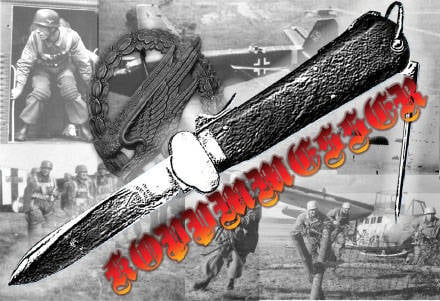
The thirties of the last century was marked by the birth of a new type of troops - paratroop formations, which first appeared in the Soviet Union.
The birth date of the Soviet airborne troops is considered August 2, 1930, when during a training exercise near Voronezh in two stages a unit of 12 people was landed. A year later, in the Leningrad Military District, an airborne landing detachment of 164 people was formed. In September 1935, in the manner of the Kiev Military District, over 1188 people were landed for two hours, who, having “captured” the bridgehead, provided for the landing and landing of 1766 fighters with guns and cars from aircraft. The following year, during the exercises of the Belarusian Military District, 1800 people are already being airborne and 5272 people with military equipment (guns, armored cars and light aircraft) are being flown by airplanes of the infantry division Tanks).
These exercises were attended by military attaches of many countries, but only the Germans realized what prospects this new branch of service opens up, which fits perfectly into the strategy of a blitzkrieg.
29 January 1936, the German Air Force (Luftwaffe) commander Hermann Goering orders the creation of a parachute battalion, which initiated the airborne formations of Nazi Germany. The battalion was stationed in the city of Stendal-Borstere, located near Berlin. The training center for the training of parachutists was also located here.
These units were baptized during operations in Scandinavia in the spring of 1940. The landing units were successfully used at the first stage of World War II during operations in Belgium, Holland, Greece, Denmark, Norway and Poland and received the nickname “Green Devils Goering” from their allies.
The airborne units of the Luftwaffe belonged to the elite of the German armed forces, the most advanced types of weapons, equipment and equipment were developed for them.
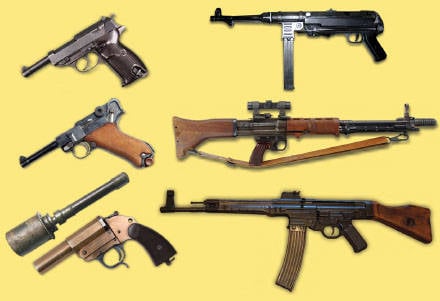
The personnel were armed with one of the best pistols "Luger P-08" (rank and file) and "Walter P-38" (officers). The famous submachine guns “Erma MP-39 / 40” (for our soldiers, they were known as Schmeiser) were developed specifically for the landing parts; Ahead of its time, the Fallschirmlandunsgewehr-42 assault rifle (FG-42); machine gun “MP-44”; signal pistol "Kampfpistole" with a rifled barrel, which allowed firing of signal rockets, high-explosive fragmentation, explosive and smoke grenades; anti-tank rifles PzB 39 and sPzB 41.
For transporting light artillery weapons, the original small tractor Kettenkrad was used, and the largest Me-321 glider in the world was created to transfer personnel and equipment, which later became the basis for the giant Me-323 transport aircraft.
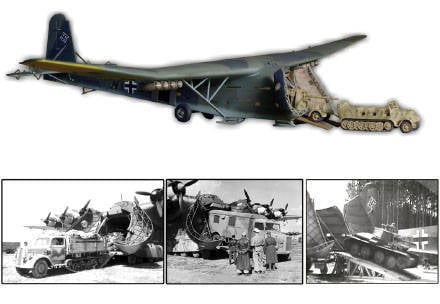
Against this background, it is surprising that RZ1 (up to 1940 of the year) RZ16 (up to 1941) and RZ20 (RZ - Ruckenpackung Zwangauslosung backpack parachute) with an extremely unsuccessful fastening system were used as one of the main types of weapons - the parachute system. sling to the harness based on the outdated Italian system Salvatore. The only advantage of this system was that it allowed to drop from fairly low altitudes 100 – 120 m (during the operation in Cyprus, part of the paratroopers were dropped from the altitude 75 m).
At the same time, this system had significant drawbacks:
- strong jerk when opening the parachute dome;
- parachute mount did not allow the parachutist to control the direction of descent;
- high rate of decline.
These shortcomings required the paratroopers to master a rather complicated parachute technique, in order to avoid injury due to a strong dynamic impact when opening the parachute dome (the famous “dive” of the German paratroopers). In addition, due to the fact that the parachutist could not control the parachute during a descent, he could hang on trees, buildings, land on the water. The inability to control the descent direction made it impossible to extinguish the descent rate (3,5 – 5,5 m / s) due to the turn in the wind. Therefore, the landing was accompanied by a pretty strong blow. And since the body of the parachutist was tilted forward at an angle of 45 ° due to the features of the mounting system, when landing, he simultaneously touched the ground with his toes, knees and hands. To counteract the force of the strike, the parachutist performed a forward roll.
Acrobatic somersaults in the air and on the ground, accompanied by dynamic loads, led to the fact that the landing was carried out "light." Of the weapons, the paratrooper had only a gun. All equipment and other weapons were thrown away separately in special containers. In addition, it was necessary to develop a special helmet, protective knee pads and elbow pads.
In addition, the features of the system did not allow to quickly extinguish the parachute canopy by adjusting the length of the lines. With a strong wind parachutist often overturned on his back and dragged along the ground. It is not surprising that even with the use of special protective elbow pads and kneecaps, injuries were frequent. In order, if necessary, to quickly get rid of parachute lines, the paratrooper needs some kind of compact cutter.
All these problems were unknown to the allies, since their parachute systems were free from these shortcomings, and the parachutist always had the opportunity to do this with a regular combat knife that was in his custody during an ejection for cutting the lines.
For quick release from parachute lines, the Luftwaffe commissioned a special knife-cutter, which entered service for airborne units of fascist Germany 24 in May 1937.
The knife was called “Fliegerkappmesser - FKM” (flight cutter) or “Kappmmesser” (knife cutter).
In Western literature, this knife is also known as “Luftwaffe Fallschirmjäger-Messer” (Luftwaffe parachute knife), “German gravity knife” (German gravity knife), “Luftwaffe gravity knife” (German Air Force gravity knife), “(Paratrooper gravity knife”) the paratrooper paratrooper gravitational knife), the Bundeswehr gravity knife (the Bundeswehr gravitational knife), and the Bundeswehr-fallmesser (an emergency Bundeswehr knife), and so on.
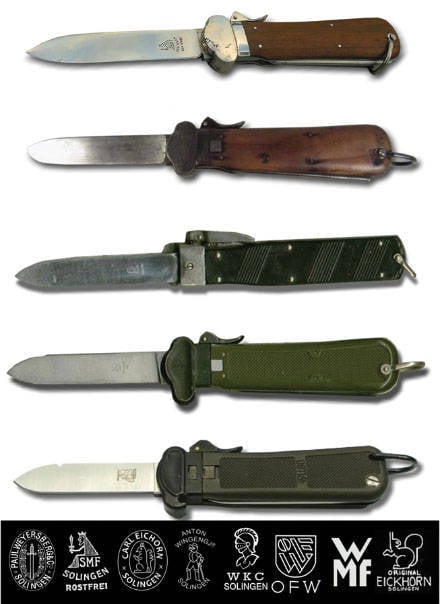
German gunsmiths managed to create a simple, compact and reliable knife, which was destined not only to survive the Third Reich, but also to become one of the most famous army knives in the world, which is still in service with the Bundeswehr and some NATO countries.
In total, five different modifications of this knife are known, of which the first two were produced during the period of the existence of Nazi Germany, the other three - in the post-war period.
The first model of sling cutter "M-1937", or Type I FKm was produced in the period from 1937 to 1941 in Solingen, at the enterprises of the German companies "Paul Weyersberg & Co" and "SMF" (Solinger Metallwaffenfabrik Stoecker & Co).
The total length of the knife was 25,5 cm, when folded - 15,5, see. The blade had the classic shape of a pen knife with a drop point, made of stainless steel and had a length of 10,5 – 10,7 cm with a thickness of a butt - 4,0 – 4,2 mm. To prevent corrosion, all metal parts were nickel-plated.
The handle covers were made of oak, walnut or beech and were attached to it with copper rivets.
The knife had a non-collapsible design, in addition to the blade there was a folding pile in it - an awl of length 9,3 cm for disentangling knots. This pile could also be used as a probe to search for mines. On the handle of the knife there was a handle for fastening the exhaust cord.
Stroporez was worn in a special pocket of parachute pants over his right knee, which was fastened with buttons. For the convenience of removing the knife from the pocket, as well as preventing its loss, there was a cord that was fastened at one end to the handle of the handle, and the other to the jumper.
When folded, the blade was fixed inside the handle. Opening the knife could be done with one hand. To do this, it was necessary to squeeze the retainer, tilt it with the mouth down or perform an energetic wave of the hand, after which due to gravity the blade was moved to the working position (hence the name "gravitational" or "inertial" knife).
When operating the first model of the knife, its essential drawback was revealed - the non-separable design practically did not allow to clean the knife after contamination in the field.
This flaw was removed in the next model - “M-1937 / II” (Type II FKm), which was produced from 1941 year to the end of the war. In addition to the above companies, knives were also manufactured at the enterprises of other companies, including the company “E. A. Heibig.
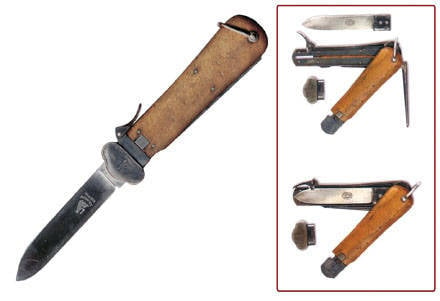
The main difference of the second model is the ability to quickly disassemble the knife into its components for cleaning it or replacing the damaged blade with a new one. Moreover, to perform these operations, no special tools were required.
In addition, oxidation was used instead of nickel plating on the guard and the lock lever, and they had a dark color.
Since 1942, the brands of the manufacturers on the blade of the knives have been replaced by their factory codes (Reichsbetriebnummer). So, for example, knives with a stamp "M7 / 43" were made by "Paul Weuersberg & Co", and "M7 / 13" - "SMF".
During the war, due to the shortage of raw materials on the blade, first, instead of nickel-plating steel, oxidation was used, and then they were completely made of carbon steel with burnishing.
The knives were not only in service with the Airborne Forces units, but also of the flight personnel of the Luftwaffe and tank units.
After the samples of the Luftwaffe line cutters fell into the hands of the British, it was decided to establish the production of such knives in England for the special divisions of the Special Operations Directorate SOE (Special Operations Executive) and other special-purpose units.
The English version of the knife was developed by the Sheffield company "George Ibberson & Co", at whose factories the first batch of 500 slings was manufactured.
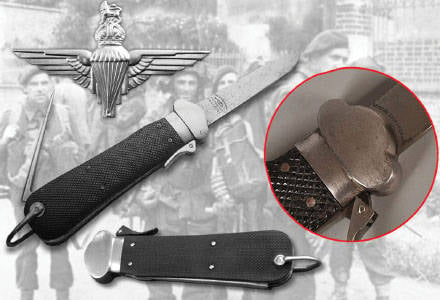
The knives completely repeated the design and dimensions of the German M-1937 / II. The exception was black corrugated handles of fiberglass bexoid, although a small part of the knives were made with smooth wooden handles. In the future, the production of such knives was organized at the factories of other companies of Sheffield and Yorkshire. In all, over the years of the war in England, around 3200 knives were released.
According to some reports, all the remaining knives after the war were brought together and flooded in the North Sea.
The first post-war model of a sling cutter - "BW Kappmesser für LL-Truppe" (Type III FKm) was released in 1955, a year after the re-creation of airborne units in the armed forces of Germany. The production of these knives was mastered at the enterprises of the companies that specialized in the manufacture of cutlery - WKC (Weyersberg, Kirshbaum & Co) and Anton Wingen Jr.. The knife had a non-separable design, and since there was no pile in it, the knife handle was thinner compared to the knives of the war period. The blade, its mouth and the lock lever were nickel-plated for corrosion protection. The black grip pads were made of plastic and were grooved in three groups of parallel stripes for a more secure grip. To prevent contamination, the mouth of the handle was closed with an oval hinged metal plug (trap door).
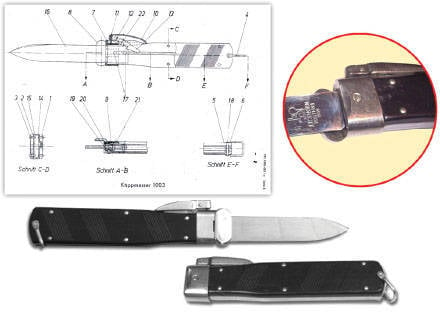
Returning to the non-separable design, the Germans stepped on the same rake as when adopting the first pre-war model of the strop cutter. In addition, many airborne veterans wanted to have in their hands the familiar knife of a military model. Therefore, already in 1961, a new version of the strop cutter was released. It was put into service (designation of the Bundeswehr - 7340-12-140-10-31, Messer, Kapp - LL - Truppe) as a knife "M-1963" (Type IV FKm). The knife was again collapsible and in appearance resembled the 1941 model of the year. The difference was in the plastic handle of olive color with grooved. The inscription “BUND” or “BW” (Bundeswehr) was stamped on the handle. This knife was manufactured by WKC, Anton Wingen Jr., WMF (Württembergische Metallwarenfabrik), OWF (Otto Förster, Witzhelden) and Carl Eickhorn Waffenfabrik AG.
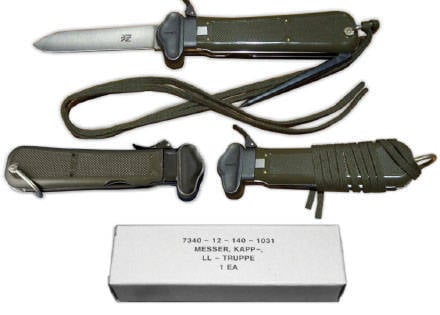
The knife is still in service with parachute, tank and aviation parts of the Bundeswehr.
Due to its reliability and practicality, the knife was very popular. After military service, military personnel often took him as a civilian with them.
The enterprises of the company "Anton Wingen Jr." also produced civilian models of inertial knives.
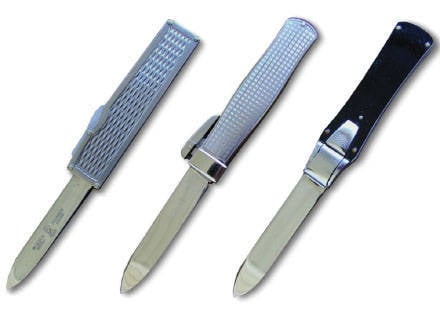
In 1975, one of the companies in which the knives of the fourth model were made, Carl Eickhorn Waffenfabrik AG, went bankrupt and ceased to exist. Created on its basis, the new company AES (Annette Eickhorn Solingen) began to produce modified cutters. They visually differed from the previous model 1963 of a smaller size and the presence of a bottle opener on the guard of the knife. The developers have reduced the number of parts of the knife, due to what the knife turned out more technologically advanced.
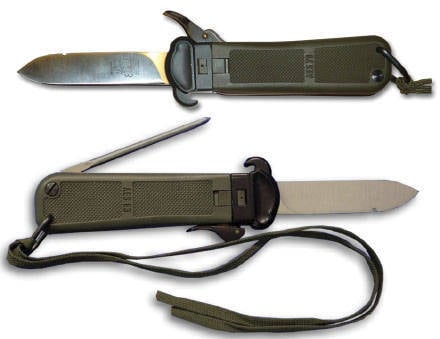
The blade of the knife (length - 8,6 cm, thickness of the butt 3,6 mm) was made of stainless steel 440 A. The olive-colored handle was made of reinforced polyamide. The name of the company “AES” and the year of manufacture (AES 1978, AES 1979, etc.) were put in the central part of the handle. The total length of the knife was 28 cm.
A few years later, the company suffered the fate of its predecessor - it went bankrupt. The company's shares were bought by the Scottish company “LBA Systems Limited”, to which all rights to use the Eickhorn brand, patents and all intellectual property were transferred. The production of knives "AES" continued under the brand name "Original Eickhorn-Solingen Limited", but with the new name "LL 80" (LL - supposedly from Luft-Lande - air-to-ground). In addition to the blade with a conventional blade, there were also options for a knife with a gray cut. The knives were intended for civil and military use (respectively, had a black or olive handle).
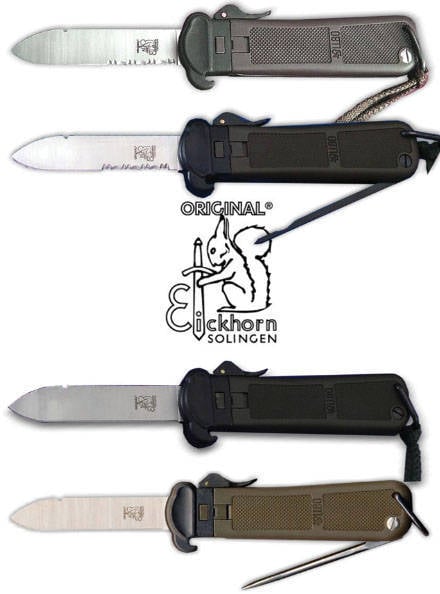
All these knives advanced on the market like knives paratroopers. However, they were never armed with the Bundeswehr, although they were used in military units. In foreign literature, they are sometimes called the fifth generation of German cutters (Type V FKm).
In the 2003 year, after tightening the legislation, the production of commercial options for a knife cutter in Germany was discontinued.
At the beginning of the 1980's. On the basis of the “LL-80” strop cutter, a knife version was developed for departments and services working in emergency situations - firefighters, police, etc. The knife was named “RT” (RT - rescue tool - “emergency tool”). The knife was produced in two versions - "RT-1" (with a red handle) and "RT-1 TAC" (black). Unlike a paratrooper of a paratrooper, the edge of his blade was in the form of a hook, and part of the blade was a sharpening in the form of a small-toothed saw (seryitor). In addition, the guard of the knife had a conical cullet. The total length of the knife was 22,2 cm, the length of the blade - 8,5 cm with the thickness of the butt - 3,3 mm. For the manufacture of the blade used stainless steel X55 CrMo14 (1.4110), the hardness of the cutting edge - 56 units. Rockwell. Knife weight - 210 grams.
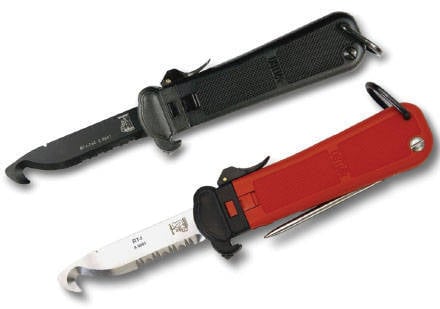
The practicality and reliability of the design of this knife, as well as the surrounding aura of Luftwaffe paratroopers, led to the production of its copies in more than 50 countries of the world. In the USA, this knife is produced by the company “Colt” under the name “CSAR Tool LL80” (Colt Search and Rescue - a knife for rescue and emergency situations).
The total length of the knife is about 22 cm, with the length of the blade 8,5 cm. The blade 3,3 mm thick is made of stainless steel 440 A. Knife weight - 210 grams.
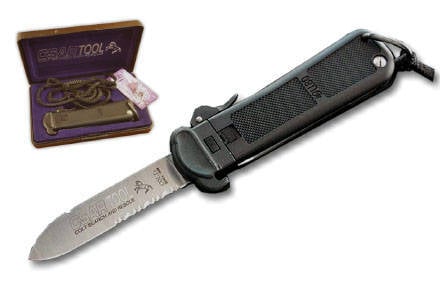
In knife literature, a cropper cutter is often referred to as combat knives. However, there is no real evidence of its use in melee fights. In addition, like all knives with front ejection of the blade OTF (out-the-front), it had a strong backlash of the blade. To enhance its combat properties, foreign copies of these knives were supplemented with brass knuckles, on its basis knives with a fixed dagger-shaped blade were produced.
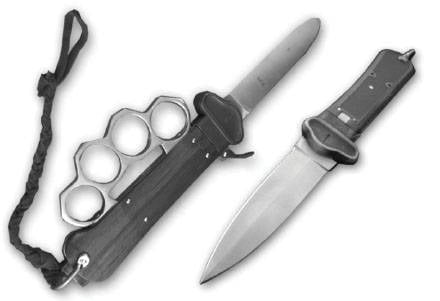
In general, the strop cutter was used by the military primarily as a convenient multi-functional tool. Especially as the combat knife "Luftwaffe kampfmesser M42" was in service with paratroop formations.
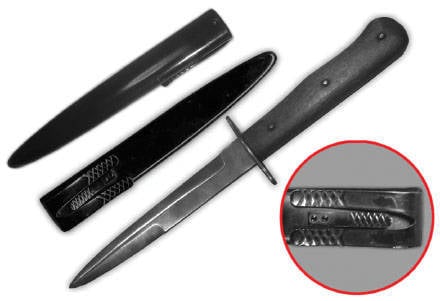
In his book, The Military Knives of Special Forces, Dietmar Paul, a well-known expert in the field of cold arms, writes that when asked about the use of this knife in the melee combat, the German airborne forces veterans could not recall a single such incident. Most likely, this use of the commusser occurred only during the famous “Mercury” operation in Crete. However, this was dictated by extraordinary circumstances. Due to bad weather and strong opposition from air defense, some of the paratroopers were thrown directly over enemy positions, and they had to go into battle immediately after landing, having only a pistol and a stroporez (losses during the operation amounted to 3637 her participation).
After the operation “Mercury”, many paratroopers began to drag their stroporez, giving the blade a dagger shape, so that after landing, they would have to carry a knife along with the pistol, which could be used as a melee weapon.
For the sake of justice, it should be noted that the training program for the hand-to-hand fighting of special forces of England during the war included training in fighting the English equivalent of a knife, including the use of pile-sewing for silent removal of sentries.
As already noted, in the Allied airborne forces there was no need for a special parachute knife-cutter. In the USSR, such knives appeared only in the 50-ies. last century. Their production was organized at the October plant (now the Saro enterprise) in the city of Vorsma.
The blade of the knife had a length of 13 cm, with a length of the handle - 10 cm. The blade of the knife was a double-sided saw of the concave shape. The tip of the blade for safety had a rounding. The knife was produced in several versions, differing in the shape and size of the blade and handle. The knife was completed with leather sheath, which were later replaced by plastic.
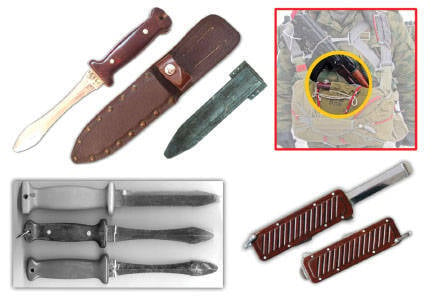
This stroporez was in service with units of the Air Force and Airborne. In the airborne troops, it was used mainly in training centers, although a certain amount was received in the line units. Usually, a standard bayonet was used as a strop cutter, which is located in a special pocket of a reserve parachute during a parachute jump.
At the end of 50's a more compact and safe version of the strop cutter was released. In everyday life, the knife is called "NP-58" by the name of one of the parachute models. His blade, like the German knife, was pulled out of the handle under its weight. The blade of carbon steel with double-sided sharpening did not have sereytor. The lining of the handle of the stroporez were made of bakelite. However, the practice of its use has shown that due to the reduction in the size and shape of the blade, as well as its strong backlash, it was less convenient and practical. The knife was produced before the start of 1980-xx.
The same knives were in service with the Warsaw Pact countries.
Information